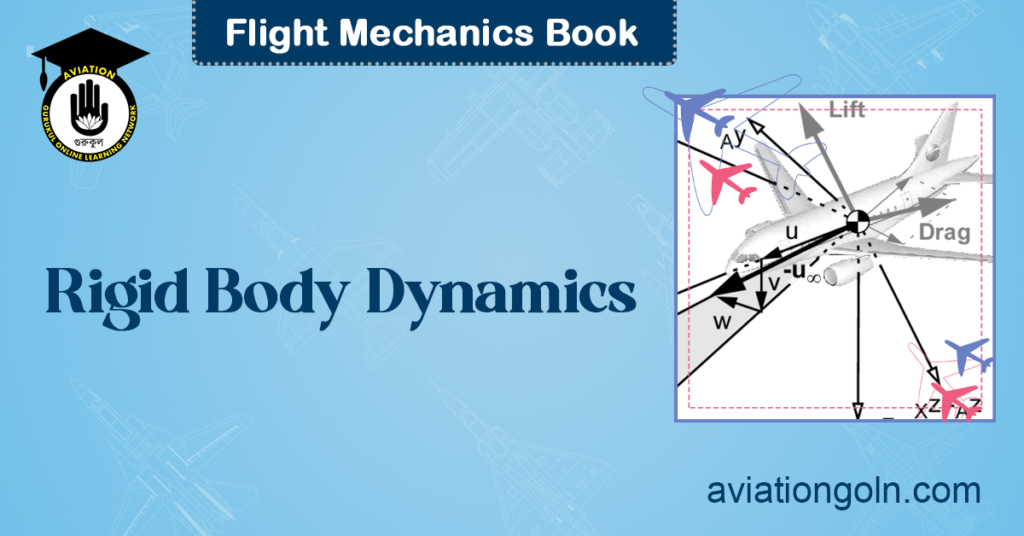Rigid Body Dynamics is a branch of classical mechanics that studies the motion of solid bodies in space, assuming that these bodies don’t deform under the action of external forces. This assumption simplifies the complex equations of motion, making it possible to analyze and predict an object’s behavior more easily. In aviation, the concept of rigid body dynamics is foundational for understanding flight dynamics.
Rigid Body Dynamics
1. Rigid Body Dynamics: A Brief Overview
Every object in motion, whether it’s a spinning top or a soaring plane, has two primary forms of energy: translational (movement from one point to another) and rotational (spinning around an axis). The principles of rigid body dynamics help us dissect these motions and understand the underlying physics.
- Translational Motion: Relates to the movement of the body’s center of mass.
- Rotational Motion: Concerns the body’s rotation around its center of mass.
2. The Core Principles of Flight Dynamics
Flight dynamics involve the study of the forces and moments that act on an aircraft, and how it responds to them. An aircraft in flight is free to rotate in three dimensions: pitch, roll, and yaw.
- Pitch: Nose up or down about an axis running from wing to wing.
- Roll: Tilting of the wings up or down, about an axis running from nose to tail.
- Yaw: Nose left or right about an axis running top to bottom.
3. Forces Acting on an Aircraft
Four primary forces act on an aircraft:
- Lift: Generated by the wings, opposes the weight of the aircraft, and holds it aloft.
- Weight (or Gravity): Acts downwards and is caused by the gravitational attraction between the aircraft and Earth.
- Thrust: Produced by the engines, propelling the aircraft forward.
- Drag: The resistance encountered by the aircraft as it moves through the air.
Balancing these forces is crucial for stable flight.
4. The Dynamics of Pitching
Pitching motion revolves around the lateral axis of the aircraft. The crucial aspects related to pitch are:
- Angle of Attack: The angle between the wing’s chord line and the oncoming airflow. A significant determinant of lift.
- Center of Gravity (CG): The point where all the weight of the aircraft is considered to be concentrated.
- Longitudinal Stability: Refers to an aircraft’s tendency to maintain its current angle of attack and pitch attitude.
Aircraft with their CG too far forward might be stable but challenging to control, whereas those with the CG too far aft may be unstable.
5. Roll Dynamics
The rolling motion is about the aircraft’s longitudinal axis. Factors impacting roll dynamics include:
- Ailerons: Control surfaces located on the wings that can be deflected up or down to induce roll.
- Dihedral Angle: The upward angle of the aircraft’s wings. Positive dihedral contributes to roll stability, as when the aircraft rolls to one side, the lower wing generates more lift than the higher wing, pushing the aircraft back to a level position.
6. Yawing Dynamics
Yaw is the rotation about the vertical axis of the aircraft. Aspects associated with yaw include:
- Rudder: A control surface attached to the vertical tail fin, helping control yaw by deflecting left or right.
- Directional Stability: An aircraft’s tendency to align with the oncoming airflow. If disturbed from straight flight (due to a gust, for instance), an aircraft with good directional stability will naturally return to its original heading.
7. Coupling of Flight Dynamics
In real flight conditions, pitch, roll, and yaw can’t be entirely isolated. They interact, leading to complex flight behaviors:
- Dutch Roll: A combination of yawing and rolling oscillations, often seen in aircraft with strong directional stability but weak roll damping.
- Spiral Instability: Occurs when an aircraft constantly rolls and yaws due to an imbalance in lateral forces.
8. Importance of Stability and Control
- Static Stability: Refers to the aircraft’s initial response to a disturbance.
- Positive Stability: The aircraft returns to its original position.
- Neutral Stability: The aircraft remains in its new position.
- Negative Stability: The aircraft moves further away from its original position.
- Dynamic Stability: Pertains to how the disturbances evolve over time, whether they dampen out or grow.
Aircraft are designed to have positive static stability but must be properly balanced with dynamic considerations to ensure safety and control.
9. Modern Flight Dynamics and Automation
Advancements in technology have brought forth innovations like fly-by-wire systems, where electronic systems replace manual controls, and autopilots, which can execute complex flight maneuvers with precision.
Rigid body dynamics offers a foundational understanding of the principles underlying flight dynamics. By comprehending these principles, aerospace engineers can design aircraft that are not only aerodynamically efficient but also safe and reliable. As aviation technology continues to advance, a grounding in these fundamental concepts ensures that even the most innovative aircraft designs adhere to the enduring laws of physics.
See more:

